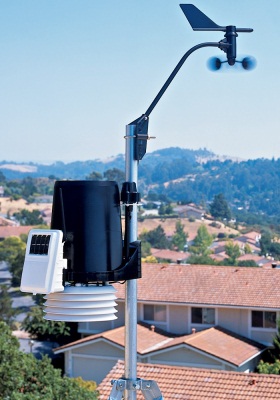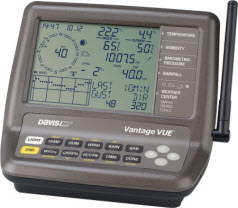The basics

An Automatic Weather Station (‘AWS’ for short) is an electronic device that measures common weather readings such as air temperature, wind, rain, atmospheric pressure etc.
It’s automatic in the sense that it will continue to report weather readings for extended periods – months to years, for instance – without any attention beyond very occasional maintenance like changing a wireless transmitter battery or cleaning the rain gauge. (In case you’re wondering, the rain gauge is self-emptying day to day and so needs no routine care).
The weather stations that we sell consist of two main parts: A set of outside sensors which actually measure the weather values (sensors for the VP2 model are shown right) and then a display console unit, usually located indoors and which provides a live readout of weather readings on a built-in LCD screen (see image below right). The outdoor and indoor components typically communicate by wireless, although there is a wired alternative on certain models. The weather readings update every few seconds, making the display a fascinating watch in windy weather.
A key feature of modern weather stations is their ease of connection to a PC (or Mac) and also of uploading to a live weather website. Let’s be clear: if you really don’t get on with computers, you can use our weather stations perfectly well without a PC connection. But PC-linking does add hugely to the benefits and enjoyment of the station and, in practice, the great majority of customers do specify the PC data logger pack.
The extra descriptions below will hopefully provide an easy introduction to our weather station products, but feel free to phone or email us if anything still isn’t clear – we’re very used to talking to customers who have never bought a station from us before. No question is too basic!
Our weather stations in more detail
 Prodata specialises in mid-price weather stations. We find that very cheap stations are typically too inaccurate, unreliable and poorly supported to offer worthwhile service; all too often these turn out to be frustrating to use and poor value for money overall. But take one good step up to the Davis range, which is the market leader worldwide in its sector, and you will find well-performing stations ranging in price (Bear in mind that a high-end weather station can cost up to £50,000 and so Davis is still a value-for-money make.)
Prodata specialises in mid-price weather stations. We find that very cheap stations are typically too inaccurate, unreliable and poorly supported to offer worthwhile service; all too often these turn out to be frustrating to use and poor value for money overall. But take one good step up to the Davis range, which is the market leader worldwide in its sector, and you will find well-performing stations ranging in price (Bear in mind that a high-end weather station can cost up to £50,000 and so Davis is still a value-for-money make.)
We offer two distinct ranges of Davis weather stations: the Vantage Vue (display console shown right), which is the more basic but cheaper model, and the Vantage Pro 2 family of stations, which are expandable and hugely flexible for more advanced applications. (Follow the links for a quick introduction to the Vue and VP2 stations.)
All Davis stations measure the following weather readings as standard:
- Wind speed and direction (with wind gust updates every 2.5 seconds);
- Air temperature (measured inside a well-designed Stevenson screen as standard to eliminate the effects of direct sunlight);
- Relative Humidity and Dew Point temperature;
- Barometric pressure;
- Rainfall over various periods, eg daily, monthly etc, and including a record of maximum daily rainfall rate;
- Inside temperature and humidity (of the room in which the display console is located);
The Vantage Pro 2 models allow many additional types of sensor to be added, including sunshine intensity, UV exposure, additional temperature and humidity readings, soil moisture (for gardeners and farmers) and various other optional sensors. VP2 models also have other benefits, such as a larger display. More information is available on the introductory pages for the Vantage Vue and Vantage Pro 2 station types.
The display consoles will allow you to see current weather conditions and – especially if you have a PC connection – to create a detailed log of past conditions, but please remember that a weather station is not primarily a weather forecasting device (although all of our stations can provide a simplified forecast for a few hours ahead).
Data logger, PC, website etc.
As mentioned above, connecting a weather station to a PC can add hugely to its capabilities for visualising your weather data as impressive graphics and for reviewing and storing the weather records in considerable detail. No other accessory will give you more benefit and satisfaction than adding the data logger for linking to a PC and, if you wish, to a website also.
Uploading the weather data automatically to a website adds a whole new dimension for sharing your live weather data with the world at large. Even if you hate computers, we have data logger models that will take care of uploading your data to a website without even needing a PC at all (see reduced image left).
For the stations we sell, a data logger pack is essential for linking the station to a PC. The logger is a true data logger being able to store the weather data for extended periods (days to months, depending on its settings) without needing to be attached to a PC.
Davis use the term ‘Weatherlink’ to refer to anything associated with the data logger. Thus a standard Weatherlink pack contains a data logger with a USB cable to connect to the PC and also a free copy of the Weatherlink for Windows software. (Other types of logger are also available, including the IP logger which connects directly to the Internet without needing a PC, together with software for the Mac.)
More information can be found on our introductory page about connecting to PCs and to websites.
Who buys weather stations?
Many people are simply interested in checking what the weather is actually doing day to day in numerical readings and in comparing values between seasons and successive years. But there are also many educational and business applications where weather monitoring is valuable and sometimes essential, for example:
- Schools and colleges benefit in many ways, using the weather data in geography and climate change studies, and in many ICT and technology applications. And having live weather on the school’s website will certainly raise the school’s profile in the local community;
- Any club whose activities are weather dependent can show live weather on a website for members to view from home;
- Farmers obviously need good weather data to help with planning planting, spraying, irrigation etc;
- Many businesses have a practical or legal need to log their local weather conditions day by day as a detailed record for future reference;
Siting the weather station sensors
Finally, a word about siting the weather station sensors. To get maximum accuracy in the weather readings, the weather sensors should really be correctly exposed. In a nutshell, the anemometer (for measuring wind speed and direction) should ideally be as high as possible, while the other sensors should be closer to ground level and in as clear and open a space as possible. The mounting hardware for the sensors (pole, post etc) is the only item not included with the weather station. We sell both a tripod and a short (1m) pole as optional extras, although it’s often easiest to source a suitable pole locally.
In practice, it’s very often impossible to meet these idealised requirements exactly, either because of the design of the station (as with the all-in-one design of the Vue) or because of limitations in where the weather station has to be located, and so some compromise in siting is unavoidable. Don’t worry overly about this – in most cases the station will still read to an acceptable standard – but do try to get as close as possible to the preferred siting conditions. Remember also that you will occasionally need to get access to the sensors for maintenance, so don’t make them impossible to reach once installed.
There is a lot more information about preferred mounting positions under our main Advice menu on the Sensor Siting pages.
A more detailed general page introducing our weather stations is available here.
